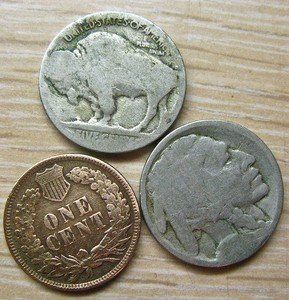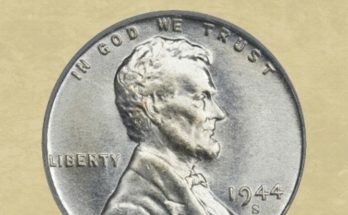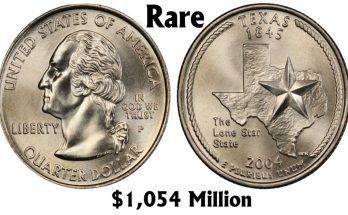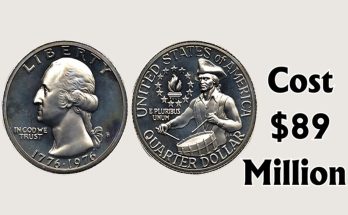Five cents Buffalo no-date nickels (those without visible dates, also called dateless Buffalo nickels and Indian head nickels with no date) may not be worth very much money — but they’re still interesting coins to collectors and non-collectors alike!
It’s important to know that every dateless Buffalo nickel did have a date at one time — because the U.S. Mint did not make any Indian Head nickels without dates.
So, why are some Buffalo nickels dateless and others are not?…
The Reason No-Date Buffalo Nickels Exist

Indian Head nickels were made from 1913 to 1938.
The reason that some Buffalo nickels have no dates is simply because the dates have been worn off after many years in circulation.
The dates on these Buffalo nickels wore off mainly due to the location of the date on the coin itself.
The date is located just on the bottom left on the Buffalo nickel — on the shoulder of the Indian. This means that the date sits high off the surface of the coin and is one of the first places that wear & tear will take place on the Indian Head nickel.
It can take many years — sometimes decades — of normal wear and tear to rub a date off a Buffalo nickel. The coin’s overall longevity was helped when the design was reworked a bit just months after the coin was released in 1913. Changes included turning the mound on which the buffalo stands into merely a line. Below the line is a recessed area where the denominational inscription “FIVE CENTS” is located. These design changes aided in eliminating the problem of the date wearing off the coin prematurely, even prolonging the coin’s typical lifespan in circulation in some cases.
Still… millions of dateless Buffalo nickels exist!
For a coin which saw heavy use during the Great Depression, you can bet that Indian Head nickels with no date would tell interesting stories if they could talk.
How Much Are Dateless Indian Head Nickels Worth?

Not knowing what year a coin was made makes it harder for that coin to tell its story — so to speak.
That’s why some people tend to throw away dateless Buffalo nickels as worthless.
But wait… those no-date Indian Head nickels are not worthless!
While still cheap, they have risen somewhat in value over the past decade. For example, dateless Buffalo nickels were obtainable for less than 20 cents years ago. (In fact, they were often spent for face value by those who just wanted to get rid of them.)
More recently, Indian Head nickels with no date have been going for as much as 50 cents — and more.
Coin dealers may be willing to pay you 20 to 30 cents for a dateless Buffalo nickel.
The Popularity Of Buffalo Nickels With No Date
While not valuable, five cents Buffalo no-date nickels are collected for many reasons.
First off, even a dateless Buffalo nickel is still highly valued by those who appreciate the romance behind the legendary American coin.
Indian head nickels hearken to an earlier, golden time in American history.
Dateless Buffalo nickels would often find homes within the workshops and studios of artisans and jewelers.
In fact, many decades ago, those down on their luck would scrape new designs on the Buffalo nickel and pass off their artwork in exchange for meals, clothing, or a bed to lie on overnight. These artistic Buffalo nickels are referred to as Hobo Nickels.
These days, dateless Indian Head nickels make wonderful gifts for young collectors. Handling an old Buffalo nickel — even one without a date — can spark the interest in a child to a pursue a hobby that can last a lifetime.
How To Find The Date On A Dateless Buffalo Nickel


Using chemicals on five cents Buffalo no-date nickels to reveal the date has its pros and cons.
Most importantly, using acid (or ferric chloride, sold as Nic-a-Date restorer) to reveal the date on a Buffalo nickel can be physically hazardous to a careless user.
It also ruins the value of the coin.
Although it will cause the date to reappear on a Buffalo Nickel which has lost its date, ferric chloride also leaves a blotchy, rough, acid spot of damage on the coin that ruins any value the nickel might have had. Also, the date will fade again over time, and each time you use the chemical again, it brings back less and less of the date (leaving an increasingly ugly acid mark instead.) Never use chemicals on the surface of your nickels to restore partial dates because partial-date Buffalo Nickels are worth more than totally dateless nickels. Depending on which digits are showing, the nickel can be worth anywhere from 50 cents (if the part showing is the first 2 or 3 digits) to about 20% of market value if the last 2 or 3 digits are readable.
~ Source
Numismatically speaking, applying any cleaner, acid, or chemical to a coin damages it in the eyes of virtually every numismatist — effectively lowering its value.
Applying acid to a dateless Buffalo nickel should be done only for the entertainment of seeing what date used to be on the coin.
That said, using acid on a dateless Buffalo nickel can sometimes reveal a scarce date, or even rare date for this particular coin.
In such a circumstance, using acid on a five cents Buffalo no-date nickel can actually be beneficial and could possibly increase the value of a formerly dateless Buffalo nickel.
Still… in most cases, using acid on an Indian Head nickel (or any coin) poses a risk to your health and effectively ruins the coin in the eyes of coin collectors.
Think of any coin that you apply acid to as one that you are sacrificing — just for curiosity’s sake.
And if you just so happen to find out that your coin has a scarce or rare date… that would be a bonus!



